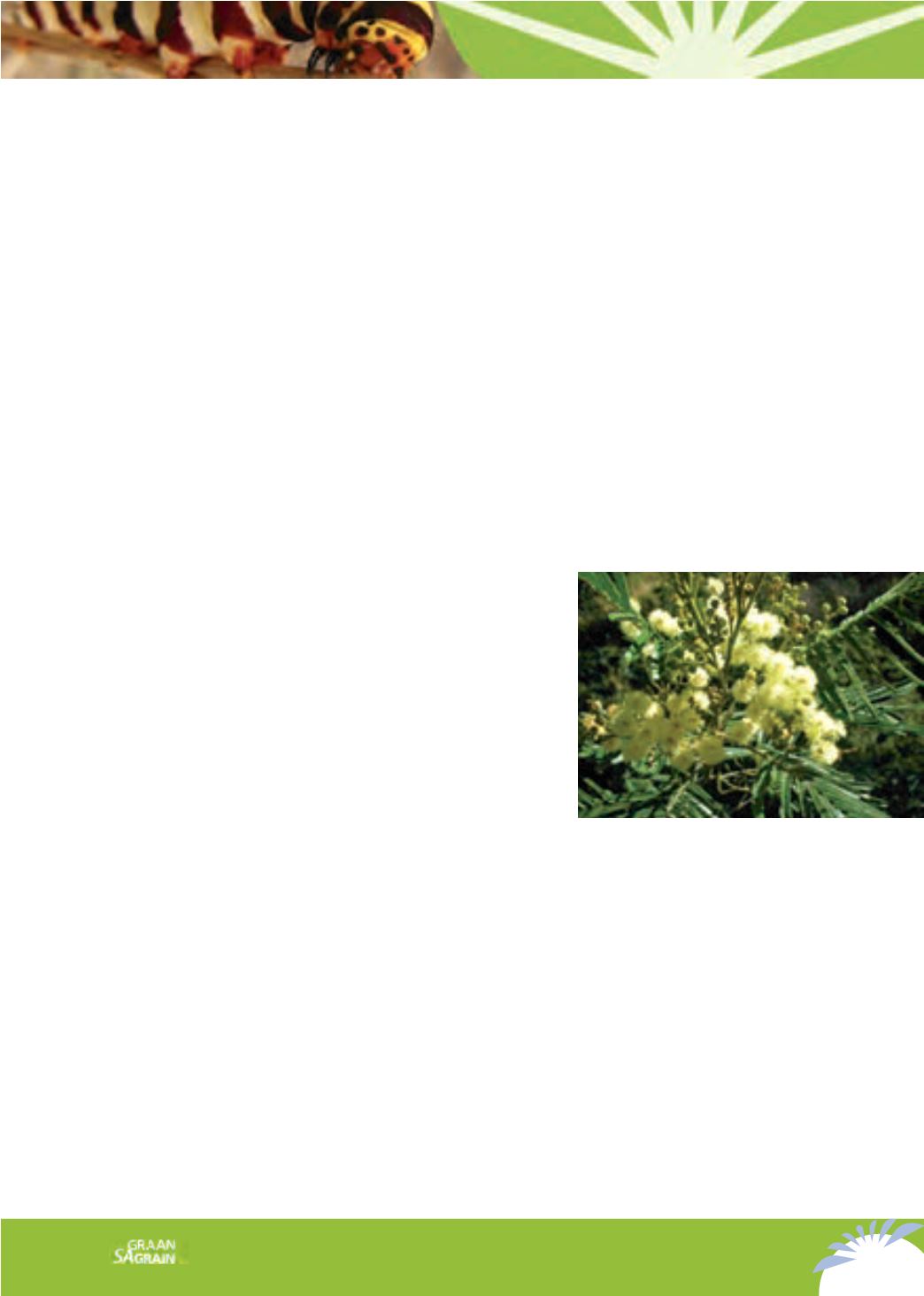

79
GRAANGIDS
2017
GRAIN GUIDE
5
4
Five of the ten main alien trees in South Africa
Continued from p. 77
Acacia mearnsii
Continued on p. 82
biological control agents were released on lantana, but the success of the bio-agents varies, as
more than 50 different types of lantana occur. Fire as control measure is not effective, as aggres-
sive sprouting will occur afterwards. Mechanical control should be applied only in combination
with chemicals, as mechanical control alone also causes sprouting. Various chemicals are regis-
tered for controlling the plant. According to the CARA Act lantana is a category 1 plant
– the landowner must therefore control it. According to NEMBA it is a category 1b plant
– it is therefore an alien species that should be controlled, removed and destroyed if possible.
No trading in this plant may take place.
Acacia mearnsii
De Wild.
Black wattle is an evergreen, unbranched tree that grows between 5 m and 10 m tall. This tree is
indigenous to Australia and Tasmania and was brought to South Africa for, among other things,
timber poles, shelter and firewood. It primarily grows in light to medium-textured soils and can
also occur in shallow soils. The root system of the tree is described as shallow but extensive. Lat-
eral roots can occur up to 20 m from the mother plant. Because of the shallow root system it is not
very drought resistant and is also only moderately frost resistant. The tree produces an enormous
number of seeds that can survive in the soil for years. Habitats where it occurs already include
grasslands, fynbos, plantations/forests and savanna. The negative aspects of the black wattle
include the following: it competes for light, space, water and nutrients; changes the landscape
and habitat; displaces and replaces the indigenous vegetation; reduces the biodiversity of the
invertebrates in the soil; reduces water flow; increases the fire
hazard (causes very hot fires) and reduces the grazing
capacity of pastures. This tree is known to have invaded
2 477 278 ha
already. If all the trees are placed in one spot,
they would occupy
131 341 ha.
The estimated annual water
consumption of black wattle is
576 million m
3
.
Biological control agents occur on this plant. Their effective-
ness varies between moderate and extensive – they should
therefore always be employed as first control mechanism.
Some of the bio agents work only on the stumps of trees
that have already been cut down to prevent sprouting. Fire
will destroy the young seedlings, but not large trees – it will
only stimulate sprouting and will also lead to seed germina-
tion. If mechanical control (cutting down of trees) is used, the
roots must also be removed, as new plants can grow from
the roots. Various chemicals are registered to control this plant and they can be used effectively
in combination with mechanical control to get rid of the trees. According to the CARA Act, black
wattle is a category 2 plant – it therefore has an economic use, but the plants may occur only
in demarcated areas and with the necessary permission. According to NEMBA black wattle is a
category 2 plant – it is therefore an alien species with the potential to invade. It has commercial
value, but can be cultivated in demarcated areas only with the necessary permits and permission.
Acacia dealbata
Link
Silver wattle is a thornless, evergreen, rapidly growing tree that becomes between 5 m and
15 m tall. This tree is indigenous to Australia and Tasmania and was brought to South Africa in
the 1880s for, among other things, its shade, as a windbreak, and for the tannin. It grows in a
wide variety of well-drained types of soil and is reasonably drought resistant. The root system of
the tree is described as moderate to deep and extensive. Lateral roots can occur up to 22 m from
the mother plant. Like the black wattle, the tree produces an enormous number of seeds that can
survive in the soil for years. Habitats in which it already occurs include grasslands, road reserves
and river banks.

















